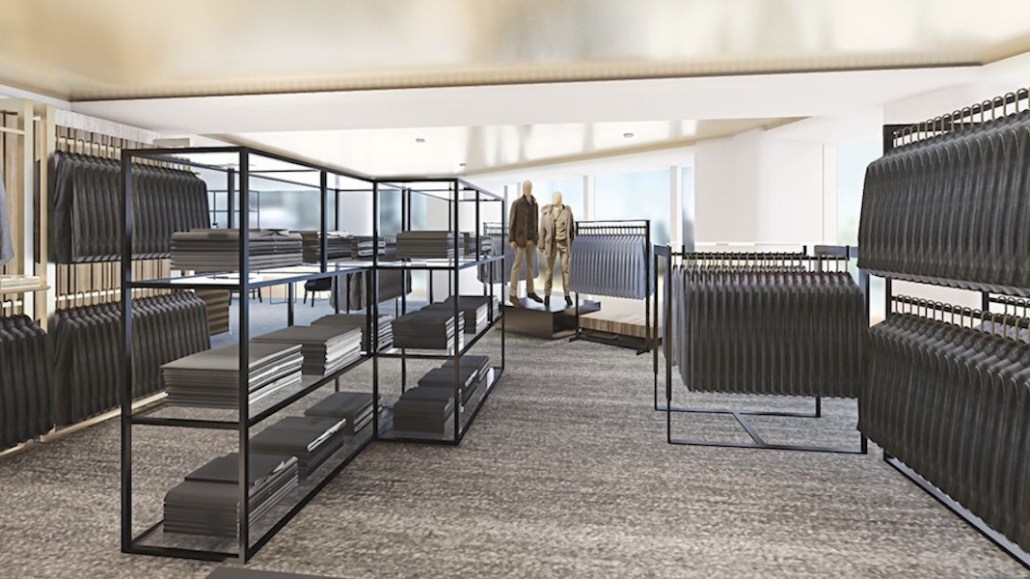Save 50% on a 3-month Digiday+ membership. Ends Dec 5.

At the new Nordstrom Men’s store, which opens Thursday in Manhattan, customers will find an assortment that focuses on streetwear, fashion-forward international brands like Gosha Rubchinskiy and made-to-order suits. The emphasis is on brands that have limited distribution in the U.S. For a widely available brand like Hugo Boss, which is one of the site’s top 10 menswear brands, the company worked with the brand’s designers to develop an exclusive product that would align well with the New York men’s customer. (Brands without a big global footprint, like Tommy Bahama, aren’t included in the New York store.) An exclusive partnership with sneaker reseller Stadium Goods is in the works, but won’t be live for the opening.
In all, the store carries a little over 200 brands across the clothing, accessories, personal care and footwear categories — about 30 percent less than the men’s department at other Nordstrom stores. More than 40 brands are exclusive to Nordstrom, or sell exclusive styles to Nordstrom.
“The challenge was, how do we show up differently?” said Thomas. “We’ve worked closely with these brands to make sure what we were offering was something that couldn’t really be found anywhere else.”
The opening of the men’s store comes at a time when the growth of the menswear industry is outpacing that of the women’s. Over the next three years, menswear is predicted to grow by 3 percent, while women’s will grow by 2 percent, according to retail data company Edited. By 2020, the menswear market is predicted to be worth $33 billion, an increase of 14 percent since 2015.
“Menswear is a huge opportunity for retailers right now,” said Tara Drury, menswear analyst at Edited. “But it comes down to research and knowing who the demographic are. Menswear in retail is very fast-growing, and and it makes sense for brands to capitalize on that.”
Nordstrom is focusing on channeling existing trends in the category — streetwear, bespoke suits, sneakers — in the store, and breaking them into “branded experiences” or shop-in-shops. Stadium Goods, for instance, will eventually have a dedicated branded store within the Nordstrom store where it will sell some of its aftermarket sneakers. Nike will have a branded shop with exclusive products. Nordstrom’s vp of creative projects, Olivia Kim, is designing a branded shop-in-shop with Comme des Garcons. A made-to-order suit visualizer tool within the store will let customers scan fabric swatches and pull up 3D renderings of what their full suit would look like, and then swap in new features. The digital screen will then send the final suit to be made.
Ad position: web_incontent_pos1
Because the way men shop is changing, there’s more opportunity to expand into new categories — and more money to be made, according to Thomas.
“It’s a super exciting time to be in menswear because we’re in a fashion moment. What’s happening from a streetwear perspective, and even broader, is a pure casualization. The lines are completely blurred, and becoming even more blurred,” said Thomas. “This opens up the door for more lifestyle merchandising, which gives us the opportunity to sell more product over time.”
Thomas said this shift toward a “Vans and Valentino” approach to menswear has been happening over the past five years, and she expects it to continue for another five.
“Men take longer to update their wardrobes,” said Thomas. “We’ve been watching pant legs slowly get slimmer for years. We intend to be really aggressive with our men’s business.”
More in Marketing

Ulta, Best Buy and Adidas dominate AI holiday shopping mentions
The brands that are seeing the biggest boost from this shift in consumer behavior are some of the biggest retailers.

U.K. retailer Boots leads brand efforts to invest in ad creative’s data layer
For media dollars to make an impact, brands need ad creative that actually hits. More CMOs are investing in pre- and post-flight measurement.

‘AI is permeating everything we do’: How Guitar Center developed 2 AI tools this year
This summer, the company launched a chatbot called Rig Advisor to help customers find the right instruments and products.
Ad position: web_bfu




